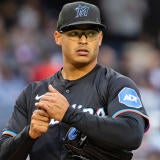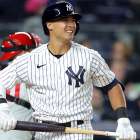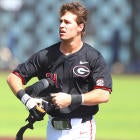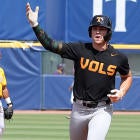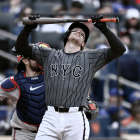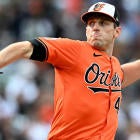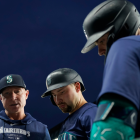
Yankees executive Brian Cashman reiterated on Tuesday that the team remains committed to rookie shortstop Anthony Volpe despite his -- and the New York lineup's -- ongoing struggles through the season's first two-plus months. "We're not shying away from Anthony Volpe," Cashman told reporters, including Erik Boland of Newsday, ahead of Tuesday's game versus the Seattle Mariners. "We believe in him, we're invested in him and we know there's a payoff there for us as long as we walk that tightrope with him."
Volpe, who made the Opening Day roster after edging out two others in a springtime competition, has to date been one of the worst hitters in the majors. He entered Wednesday batting .191/.265/.350 in his first 272 plate appearances, resulting in a wRC+ (a catch-all statistic that adjusts for ballpark) that ranks 156th out of 159 qualified batters. Only Nick Maton, Alex Call, and Jose Abreu have produced less at the plate so far this year.
Granted, Volpe isn't the only Yankee who has struggled this season. As a team, they come into Wednesday ranked 17th in runs scored and 20th in wRC+ -- the Oakland Athletics, Cleveland Guardians, Chicago White Sox, Detroit Tigers, and Kansas City Royals are the only AL to rank worse in that category. Combine those elements with Oswald Peraza's hot hitting in Triple-A (he enters Wednesday with a .923 OPS), and it's understandable why Cashman was asked about the shortstop situation.
With all the above in mind, let's take a look at three factors that explain how Volpe has gone from a fan favorite to a lightning rod in New York.
1. Too much swing and miss
Volpe has had his share of problems with putting the bat on the ball. He's struck out in roughly 31% of his plate appearances to date, which is more than you would've expected based on his minor-league track record. Last season in Double-A, he punched out less than 18% of the time. He did K in 30% of his plate appearances in Triple-A, but that was a 22-game sample.
Volpe has "earned" his strikeouts in a sense. He's whiffed on more than 30% of his swings, putting him in a league with the likes of J.D. Davis and Salvador Perez -- not the company you would've expected him to keep given both of their games are skewed toward slugging over contact. To wit, Davis and Perez both have average exit velocities over 90 mph; Volpe's is 88.8 mph.
A batter doesn't have to make contact at excellent or even average rates to be successful. But it sure helps if you're lacking in other areas. Say, would you look at that -- it's a convenient transition to our next topic.
2. Poor results on quality contact
While it's tempting to always look at a hitter in aggregate, sometimes you can gain an appreciation for what's going on by looking at a batter's numbers when they're making their best contact. In the ball-tracking era, that means looking at their splits when they have an exit velocity of 95 mph or greater.
Anthony Volpe with an RBI double in his first Subway Series game! 🚇 pic.twitter.com/yua5krvmem
— Yankees Videos (@snyyankees) June 14, 2023
Volpe, for his part, hasn't performed well when he's hit the ball hard. His .429 average on batted balls of 95 mph or greater ranks in the 15th percentile among hitters with at least 20 events. That group as a whole, for comparison, has hit .502. It's tempting to write that Volpe has been the victim of bad luck, and he probably has been. Alas, there may be something else at play here, too.
Volpe ranks in the 77th percentile in average launch angle (16.5 degrees). He ranks in the 20th percentile in balls hit between 10 and 30 degrees. In other words, Volpe's seeming underperformance on hard-hit balls might be the product of him hitting the ball directly into the ground or up in the air more than his average launch angle indicates he does.
3. Varying defensive opinions
Let's face it. Defense is tougher to evaluate than offense. Public-facing metrics have improved to an extent, but they remain tricky. It doesn't help that in some cases, like with Volpe, the metrics are split on a player's performance.
Take a look at how Volpe stacks up according to numerous metrics:
- DRS (Baseball Reference): 6
- UZR (FanGraphs): -0.6
- DRP (Baseball Prospectus): -0.7
- OAA (Statcast): -3
Depending on your metric of choice, Volpe is either above-average; about average; or below-average. Terrific, right? His particular skill set complicates the eye test, too. When CBS Sports ranked Volpe as the 12th best prospect in the game entering the season, we concluded his capsule by stating: "Defensively, he'll have to continue to prove that he can make all the plays at short despite a substandard arm. It's possible that he'll eventually end up at the keystone."
A full dive from Volpe and great scoop from RIzzo! pic.twitter.com/tF3UlCORg8
— Talkin' Yanks (@TalkinYanks) June 18, 2023
Sure enough, Volpe ranks in the 25th percentile in arm strength, according to Statcast. His hardest thrown ball, 84.8 mph, is a full tick below the positional average. There are other shortstops with weak arms who are regarded as good defenders -- Dansby Swanson and Francisco Lindor -- but when you think about what makes a stellar shortstop, the cannon arm is part of the package. Not having that component probably hurts the young infielder, if only in perception.
Of course, this wouldn't matter so much if Volpe was sporting an above-average offensive line. He's not, and so every aspect of his game is -- and will remain -- under the microscope until he takes a step forward. The good news for him is that his front office seems to still be behind him.











